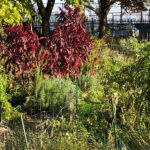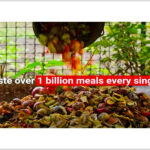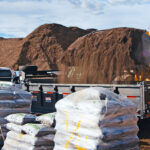Fabric structures prove to be effective in enabling a controlled environment for composting facilities.
Nate Clark
BioCycle May 2014
Many operations that rely on use of heavy machinery to perform daily functions site their facilities outdoors so equipment has ample room to maneuver. Unless these facilities are located in regions like the southwestern United States where precipitation is rare, they are vulnerable to whatever weather events a season brings: rain, snow, wind, etc. This can pose a problem for a facility like a composting site, where an operator may want to control the moisture of actively composting material, and regulators tend to want to make sure that any extra nutrient-loaded liquid runoff does not find its way to nearby waterways. It is for reasons like these that some composting facility operators choose to install fabric structures at their facilities. Fabric structures provide protection from the elements without having to spend the time and resources it takes to construct a conventional building. At the same time, they provide adequate width to maneuver large equipment, and can be modified and expanded if the need arises.
BioCycle interviewed two composting facility operators that conduct their operations under the protection of fabric structures. The University of Connecticut (UConn) Agricultural Waste Composting Facility, located near the UConn campus in Storrs, composts all of its agricultural services livestock manure under a ClearSpan Fabric Structures Hercules Truss Arch Building. SPEC Environmental Solutions, owned and operated by Hubert LeBlanc in Digby County, Nova Scotia, Canada, is a 330-acre commercial composting facility where wastes from the local mink and fishing industry are processed under the cover of three Britespan Building Systems’ structures.
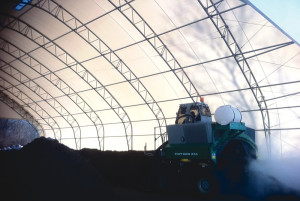
Operators at the UConn Agricultural Waste Composting Facility have ample space within the ClearSpan fabric structure to maneuver a 17-foot wide Komptech windrow turner.
UCONN Agricultural Waste Composting
The University of Connecticut (UConn) Agricultural Waste Composting Facility is operated by the UConn Farm Services Department, under the direction of Mary Kegler. UConn designed and constructed the composting facility in 2011 to better manage a portion of the livestock manure generated by the 200 dairy cattle, 40 mature beef cattle (that also calve, potentially doubling the herd size), 50 to 60 mature sheep, 85 horses, and 1,000 to 1,500 chickens that the department raises at any point in time. Before composting began, Farm Services staff would collect and land apply a majority of the animal manure, causing higher than recommended phosphorus levels in agricultural soils.
The composting facility, which also processes some green waste (mainly grass clippings and leaves) from the UConn campus, has been effective at removing 40 to 45 percent of the animal manure from the agricultural operations’ waste stream, relieving the pressure to land apply the phosphorus-rich manure. After considering the increased costs of operating a campus food waste composting program (i.e., additional collection containers at dining halls; hauling material to composting facility) and potential problems with neighbor relations regarding odors and attraction of pests, staff at the UConn composting facility decided not to accept any food waste from the UConn campus or any outside generator.
Composting is done using a windrow system, housed under an 86-foot wide by 120-foot long ClearSpan Hercules Truss Arch Building. Kegler explains that from the get-go, staff intended on installing a structure. “When we decided to build the facility, we wanted to cover the operation for two main reasons,” she says. “We wanted to control the moisture levels of the feedstocks and active compost because if it is wet, the material does not heat up as quickly and takes longer to break down. Also, a cover protects the active compost from the elements, like rain, that may lead to nutrient leaching from the facility.”
UConn’s Farm Services staff construct and maintain four active windrows within the 10,000 sq. ft. ClearSpan building at any time, which still leaves enough room to comfortably maneuver a 17-foot wide Komptech windrow turner. Active material stays in windrows for three to four months, before it is moved to a 100-foot by 100-foot concrete curing pad directly behind the fabric structure. Kegler estimates the composting facility takes in about 1,800 to 2,000 cubic yards (cy)/year of agricultural waste (mainly semisolid animal manure). Because efficiency and processing as much volume as possible are the goals of the composting operation, Farm Services staff attempt to minimize the amount of liquid manure incorporated in their compost recipe. Liquid manure from the dairy cow operation is collected and kept in a storage tank to be processed elsewhere, while the dry manure from the horse barns and a few other agricultural operations is collected and processed through the composting facility.
Depending on the feedstock, the moisture content of those feedstocks, and the weather, Kegler believes UConn’s facility can process up to 11 windrows annually (~120-125 cy each), totaling about 1,000 cy/year of finished compost. Farm Services staff constructed a screener that screens finished compost to roughly a half-inch, but Kegler states that because all of the feedstocks the facility processes are already pretty fine, screening is not always required. A portion of the finished compost is retailed from the facility for $16/cy, and the rest is applied to the UConn Agricultural Department’s fields.
The building from ClearSpan Fabric Structures has been “worry-free,” adds Kegler, performing as well or better than their expectations. Because UConn is a state entity, all purchases over $10,000 must go out to bid, but she says staff based the specs for the structure on a ClearSpan design. According to Paul Ferri, Environmental Compliance Analyst with UConn’s Office of Environmental Policy and a key planner for the composting facility, a fabric structure was chosen for the site due to affordability and ability to expand. “ClearSpan’s structure is very adaptable and will make expansion easy,” Ferri told BioCycle.
As for maintenance and repairs, Kegler notes they have not experienced any problems with the structure, even with the increased severe storm events during the winter and summer months. “The take home lesson is we definitely have an advantage with the covered structure in that we can keep feedstocks and active compost out of the elements. This speeds up the composting process and helps keep the process operating neatly and efficiently. We do tours of our facility and we are never afraid to bring people back there. The building from ClearSpan Fabric Structures and the cover it provides make it that way.”
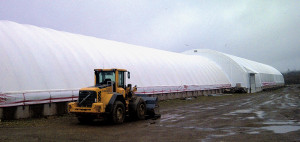
SPEC Environmental Solutions processes 8,000 tons of organic waste from the regional mink and fishing industries each year, all under the cover of three Britespan fabric structures, totaling 31,000 sq. ft.
SPEC Environmental
Hubert LeBlanc, owner and operator of the SPEC Environmental Solutions commercial composting facility in Digby County, Nova Scotia, has been involved in composting of some type for over 40 years. Prior to opening the SPEC Environmental Solutions commercial composting facility in 2001, LeBlanc and his brothers owned and operated the largest pork farm operation in the province (closed in 2008), where he practiced on-farm composting of both the manure and dead carcasses.
According to LeBlanc, as the mink industry in Nova Scotia continued to expand, the problem of what to do with all of the industry waste became an issue. At that point, the waste product was being taken to a rendering plant, but no one would want to use the rendered material. For this reason, LeBlanc was approached in 2001 by some of the mink industry leaders, and as a result, opened up his facility and made the transition from small-scale on-site composting of waste from his pork operation, to large-scale, commercial processing of waste from the regional mink and fishing industries. Finished compost is either retailed by the yard as is, or mixed with fifty percent topsoil and retailed as a planting mix well suited for gardeners and greenhouses.
SPEC Environmental operates a 31,000 sq. ft. facility that utilizes a windrow system to process 8,000 tons of organic waste annually. All composting and processing is completed under three Britespan fabric buildings. LeBlanc notes two main reasons why he chose to house his operation under the cover of a fabric structure. “In Nova Scotia, regulators require that all composting be done under cover to reduce excess liquid runoff from entering nearby waterways,” he explains. “So the first reason is we are required to have a structure. The second reason is that keeping active compost out of the elements makes our product a lot easier to handle and move around, and the structure makes for a better work environment for our 30-plus staff members. It is more satisfactory for our workers if they are out of the weather and wind.” He adds that another advantage to a fabric structure versus a conventional building made of materials like brick or wood, is that once the decision is made to install a fabric structure, you have a waterproof operation within weeks versus the construction time of a conventional building of the same size.
After looking at multiple suppliers, Britespan’s experience in the industry, product durability, and the ease to construct and maintain the structure, helped LeBlanc with his decision to choose Britespan, he notes. And the structures have lived up to the expectations he had when he purchased his first one. “In spite of rain, snow, and wind, the first Britespan we installed looks the same as when we put it in. We haven’t done any repair or maintenance to a structure at this point. We even punctured about an 8-inch hole with a bucket loader in the first structure we installed, but we haven’t had to fix that hole because it never got any bigger!” He adds that if he did ever encounter an issue, he is confident that the Britespan distributor in his region would be immediately available to help. “The Britespan dealership in our area has been very good,” LeBlanc says. “Anytime we buy anything, we look at the person or dealership that is selling it, because we want to be sure we can communicate with the vendor.”





